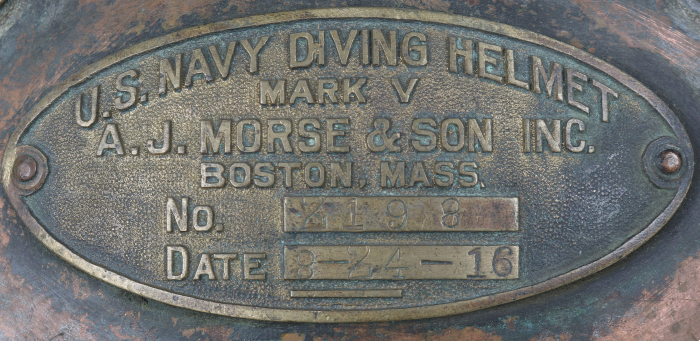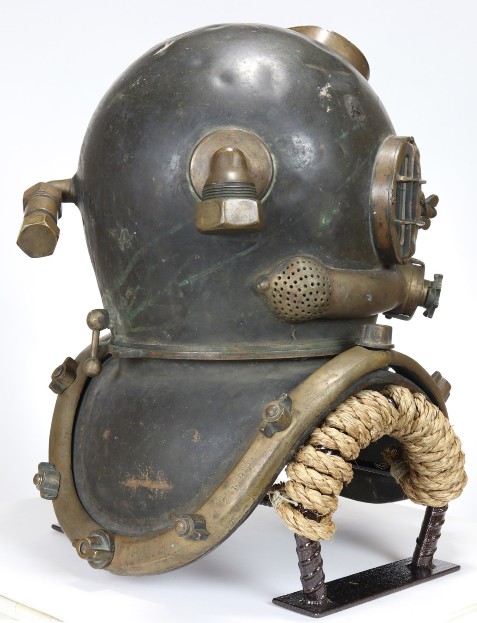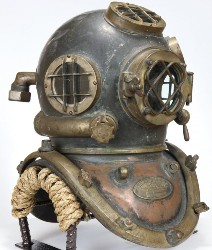
What you see: A 1916 U.S. Navy Mark V diving helmet, the earliest known example of the type. Nation’s Attic estimates it at $20,000 to $40,000.
The expert: Don Creekmore, co-owner and founder of Nation’s Attic in Wichita, Kansas.
What is the U.S. Navy Mark V diving helmet, and why did the Navy commission it? The Mark V was the first standardized diving helmet that the Navy used. Before that, there was no standard diving helmet design. As they were developing it, entering World War I was a distinct possibility. With any war, there’s a certain amount of salvage work to be done.
Salvage work? Such as? Recovering sunken ships, or material salvaged from ships to keep the war going.
The U.S. Navy Mark V diving helmet was in use for a long time, from 1916 to the mid-1980s. What made it such a useful and durable design? The job of the Navy diver who used this kind of helmet was essentially the same – doing salvage work. They’re not fighters. They’re very brave people, but their job is not combat. The Mark V really was an improvement over what was available prior to this. It has a lot of redundancy and safety [built in]. That’s why it was used by the Navy for such a long time. It was a proven safe design, the pinnacle of what’s called “hard hat diving.”
Do we have any idea how many U.S. Navy Mark V diving helmets were made, and how many survive? During the entire production run, tens of thousands were made, but I don’t know if it was closer to 20,000 or 50,000. The majority, probably 85 percent, were made during World War II, between 1942 and 1945. Another majority were made around 1918, for World War I, and a very small number were made between those two wars. It was simply due to demand from the government.
And the manufacturers didn’t build many more because the earlier-made ones didn’t need to be replaced? Exactly. The large number that was made around 1918 were relied on in the 1920s, the 1930s, and the very early 1940s. Around the 1940s, the Navy realized it drastically needed to increase its inventory.
Are there any big differences between the U.S. Navy Mark V diving helmets made for the two world wars, and those made later? The only difference on the ones made later in the 20th century is the windows that the diver looks through changed from glass to plastic. That’s it. That’s how good and reliable this helmet was.
How do we know this U.S. Navy Mark V diving helmet was made in 1916? This one has a clear identifying plate from the manufacturer showing the day, month and year it was made. And the serial number is in six different places on the helmet. That’s the nice thing about anything military. Commercial diving helmets from the same company had serial numbers, but not the dates. For commercial divers, who cares? But the military wants redundancy.

How do we know this U.S. Navy Mark V diving helmet is a prototype? There’s a number of minor differences in this helmet from the standard production helmet. On the back of the helmet, the places where the air line and the communication line would attach are opposite from where they normally would be on a standard production helmet. It also has parts from an English diving helmet. The manufacturer was trying to figure out what the U.S. Navy wanted and what would work best.
How do we know that the helmet is in “original unaltered condition,” as it says in the lot notes? When a diving helmet comes from the factory, it has tinning, a finish that covered the copper body of the helmet and prevented corrosion. It was standard on all helmets the U.S. Navy ordered. The top half of this helmet has well over 90 percent of its original tinning remaining, and the lower half has about 60 percent remaining. That’s quite unusual. The copper is exposed on the lower front half because weight belts were strapped across it, and the tinning wore off prematurely.
But no one has tried to touch it up. Correct. And nothing on here has been repaired, altered or moved. Other than age, everything appears the way it did on the last day the U.S. Navy used it.
I’d like some help identifying what some of the fittings on the U.S. Navy Mark V diving helmet are. In the photo that shows the helmet from the back, there’s a long fitting that juts out at an angle. What is that for? That’s for the air line.

And the shorter, stubbier fitting at the right? Was that for the communications line? Yes. At the time, it was a relatively new feature. The U.S. Navy wanted the most advanced technology incorporated in the helmet. The line itself was a big, thick telephone cable. It hooked up to the helmet, and there was a speaker inside the helmet. You could hear through it and also talk into it, but the helmet was loud.
What made the diving helmet so loud inside? Air was blasting in there at high volume. It was very hard to hear. But it was better than what was used before. Prior to this, they had a signaling system that involved pulling on the air line. Very crude communications. The telephone line was a big advancement.
What is that solid, round, flat fitting that lines up with the wearer’s temple? That was where the telephone, or the speaker, was housed. It was positioned so it didn’t hit the diver’s head. It’s more flush with the inside of the body of the helmet rather than sticking inside it.
What’s the fitting sticking out of the jaw, which has a lever handle? That’s the spitcock valve. It was a crude thing that allowed water into the helmet, if needed, so you could spit it onto the insides of the windows if they were fogging up. It was a redundancy thing. Commercial helmets generally didn’t have a spitcock valve.
So the spitcock valve was kind of like a defogger? A secondary defogger. Air blowing inside the helmet was the primary defogger. Of course you couldn’t use your hands to wipe the insides of the windows.
What’s the gear-shaped fitting on the other side of the jaw? That’s the exhaust valve. It allows you to regulate how much air is coming into the helmet and the suit itself, to make you more buoyant or make you sink more. It’s a part that’s particularly important to this helmet, because it’s an eight-pointed star wheel. After 1918, the U.S. Navy required the wheel be changed to have four points on it. It’s very unusual and rare to see an early one still on a helmet.
What does the pattern of wear seen on the U.S. Navy Mark V diving helmet tell us about how it was used? It indicates it was used and tested, but I would not say it was used as primary equipment. Normally, on the very top of the helmet, you see working dents. They’re dents from using the helmet underwater, and from when the top half of the helmet is removed and set on the ground. This has working dents, but they’re fewer, and they’re minor. It indicates limited use, and careful use as well.

How would the U.S. Navy have tested this helmet? Would it have been tested empty, or with a diver wearing it, or both? It would have been primarily tested in water, at a U.S. Navy shipyard. Maybe in Washington, D.C., but it could have been tested elsewhere. The U.S. Navy may have had a tank to test the pressure and see how much the helmet could take. It would always have had a person in it.
How does this U.S. Navy Mark V diving helmet compare to other early Mark V helmets you’ve handled? I’ve never had one this old. Essentially, it’s the oldest. I’ve had some from 1918 in similar condition. But this Mark V being incredibly old – you don’t expect to see one in complete original condition like this. It’s almost as good as you could hope for.
What’s the story behind the U.S. Navy Mark V diving helmet? How was it discovered? How did it manage to survive so well? The earliest we could document it is to the 1950s, when it was purchased by two brothers in Wisconsin as a curiosity. They put it in their house with other amazing antiques that were not nautical – or diving-related. It was discovered when the brothers sold the helmet and other nonrelated items. That buyer contacted us in January of this year. We let them know the significance of it, and they ultimately chose to consign with us.
Do we know how the diving helmet ended up in Wisconsin? It’s hard to say how it made its way there, but the U.S. Navy did make ships up there on the Great Lakes.
What is the U.S. Navy Mark V diving helmet like in person? Are there aspects that the camera doesn’t capture? The feeling of picking it up. It’s over 60 pounds. It retains all the elements that Navy divers would know in 1916. You look through the same old glass looked through by the guy who tested this potentially dangerous equipment. It hasn’t been polished, it hasn’t been messed with. The experience of it – that’s what the camera can’t capture.
If someone wanted to use this antique helmet on an actual dive, could they? It would need new gaskets and glass, and it would need to be tested for leaks. Then it would be in dive-ready condition.
How did you arrive at the estimate for this diving helmet? There has never been a 1916 U.S. Navy Mark V diving helmet to sell at auction. I sold a 1917 Schrader helmet in 2010, for $15,100. I’ve sold other helmets from 1917 and 1918 in the $14,000 range directly, not at auction. This one, though, is the cream of the crop. This is the best and earliest Mark V you could hope to have. I feel the low end being $20,000 is very conservative, and doubling it is not too crazy. It could possibly exceed that.
What’s the world auction record for an antique diving helmet? It was set in London by a helmet made by C.E. Heinke Co. and sold in the UK by Christies in 1997. At the time, based on the exchange rate, it went for $62,390, or £36,700. A diving helmet made in the United States by A.J. Morse & Son sold for $61,360 in 2010.
Why do you think this U.S. Navy Mark V diving helmet is likely to meet or beat the world auction record? In my experience, the Mark V, regardless of what year it’s made, is the most popular diving helmet worldwide. We have the most demand for it. It is the style people think of when they think of diving helmets. This is the earliest one, in good condition. It has the potential to sell for the highest amount at public auction.
As of June 11, 2020, the day we’re speaking, the diving helmet has attracted two bids, the higher of which is $14,500. The auction doesn’t take place until July 18, 2020. Is it meaningful for the diving helmet to have drawn two five-figure bids this early? It’s a big plus, I think. It indicates that even this far out, it has the potential to reach its high estimate and exceed it.
Why will this U.S. Navy Mark V diving helmet stick in your memory? The Mark V is our bread and butter. I’ve always wanted to find the earliest one. This is the earliest one, and it’s in incredible condition. As a dealer, it’s what you dream of. To me, it’s my one chance at handling the best, earliest example. I’m never going to forget this one.
How to bid: The 1916 prototype U.S. Navy Mark 5 diving helmet is lot 0181 in the antique diving helmet and SCUBA auction taking place at Nation’s Attic on July 18, 2020. Absentee and Internet live bidding is available through LiveAuctioneers.
___
By SHEILA GIBSON STOODLEY
Sheila Gibson Stoodley is a journalist and the author of The Hot Bid, which features intriguing lots coming up at auction.



